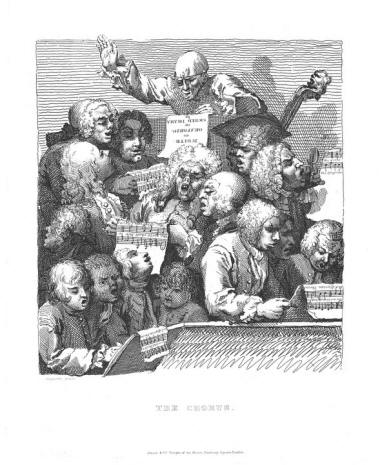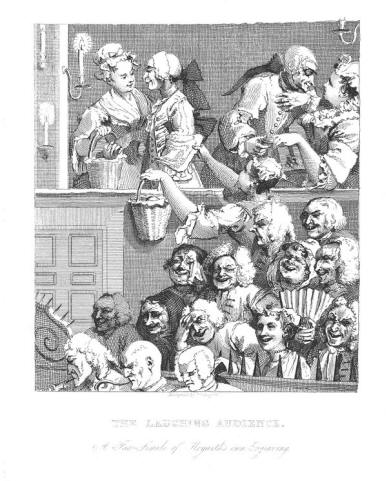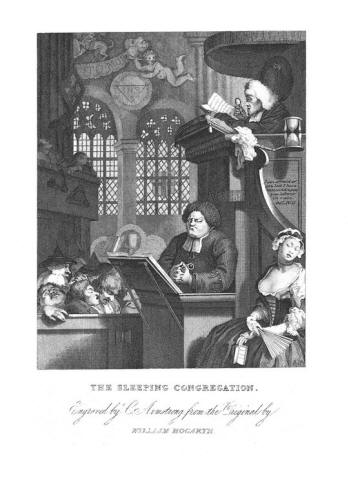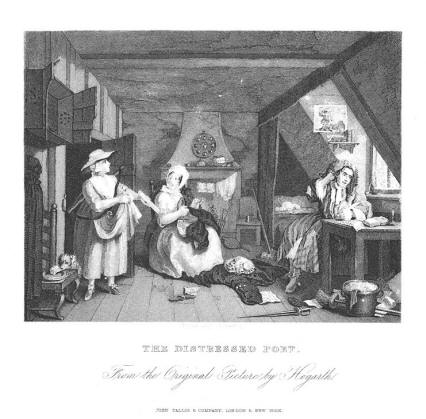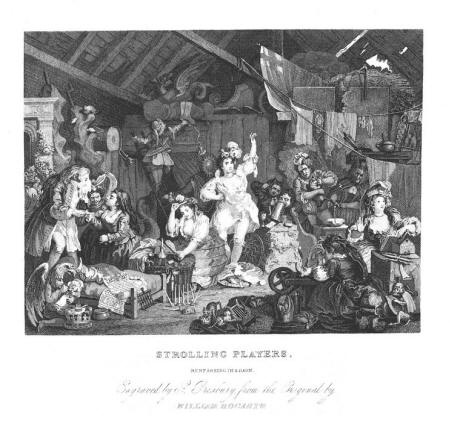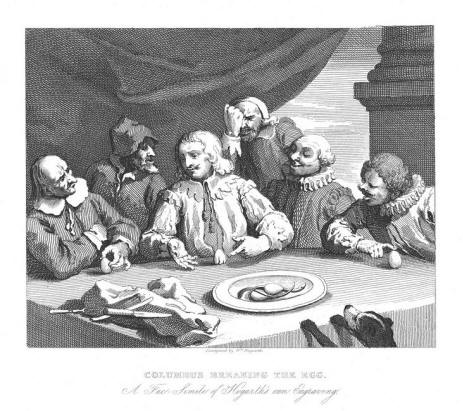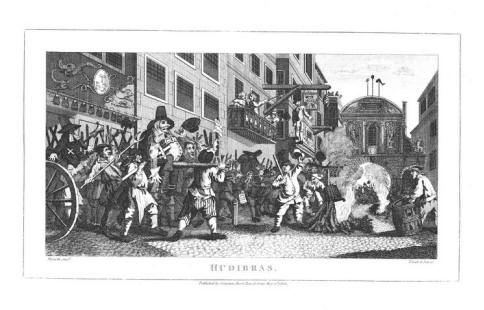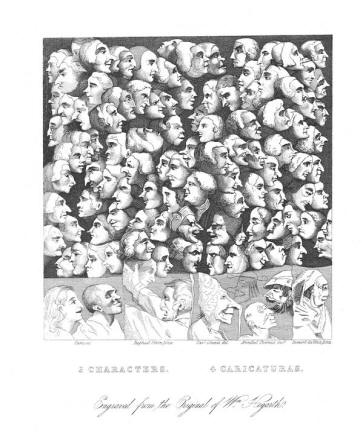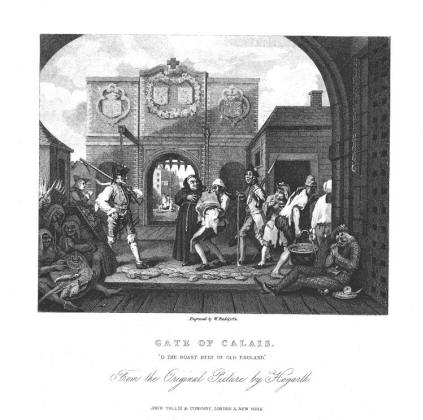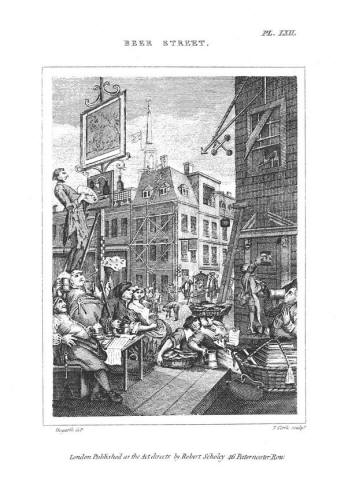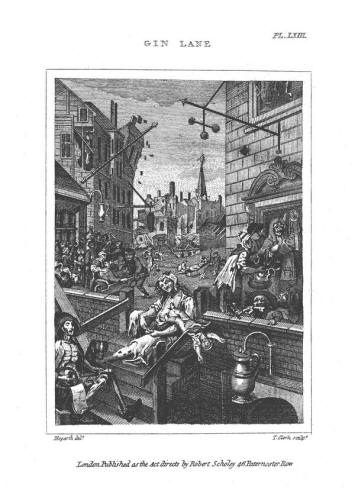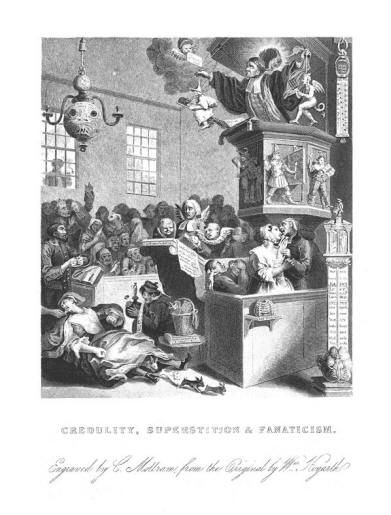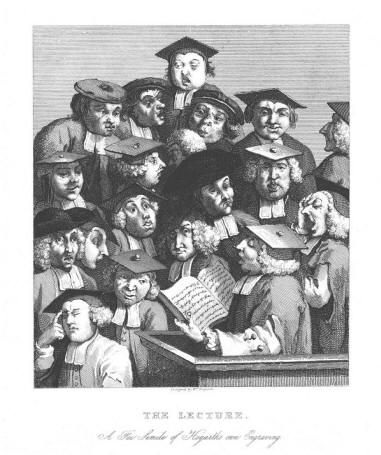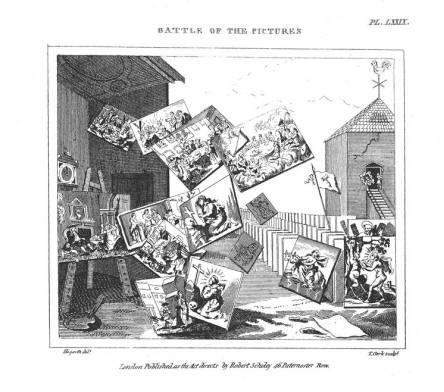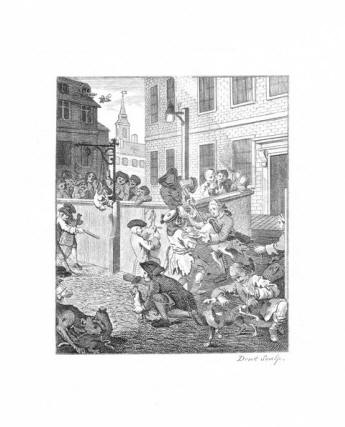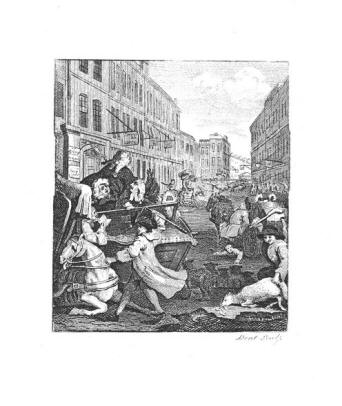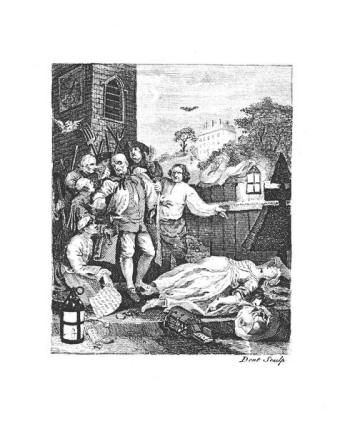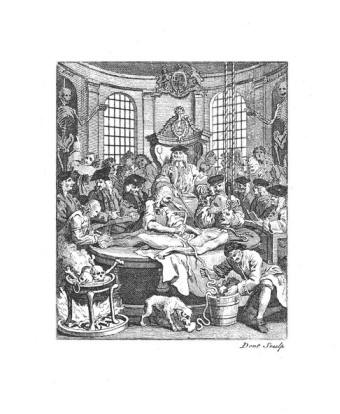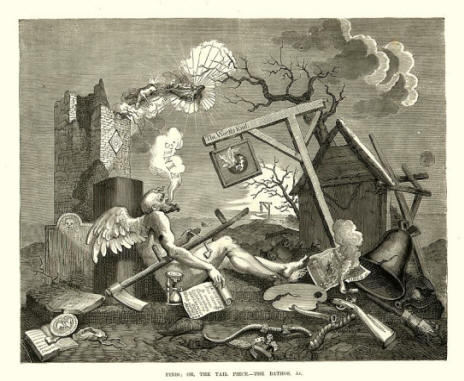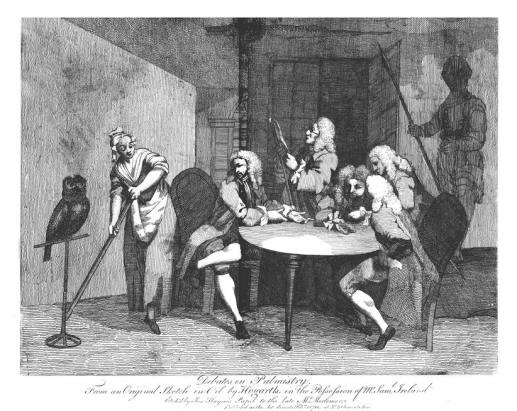|
William Hogarth 18th Century British Caricaturist
|
||||||
|
|
||||||
|
The Chorus
A Chorus of Singers was created by Hogarth in 1732 as a subscription ticket to his large engraving, A Midnight Modern Conversation. It depicts the rehearsal of an oratorio entitled Judith which was written by the artist's friend William Huggins with music composed by William Defesch. The image portrays a gamut of facial expressions of singers straining their voices to the limit. Above them all stands the choir master who has lost his wig in the ecstasy of the moment. None of the singers seems to be paying any attention to him.
|
||||||
|
Hogarth engraved The Laughing Audience in 1733 as a subscription ticket to his large engraving, Southwark Fair and to his series, A Rake's Progress. The image depicts a theatre audience. In the foreground are the heads of three orchestra performers. Behind them is the pit where commoners, except for one sour faced gentleman, are genuinely enjoying the comic drama Above them is a private box for the upper classes, where two gentlemen are occupied with other pursuits; neither is paying any attention to the drama.
|
||||||
|
The Sleeping Congregation
William Hogarth's The Sleepy Congregation is one of his most delightful comments upon the church. An old, nearsighted preacher delivers his sermon from his pulpit on high. Below the preacher sits the clerk whose attention is fixed on nothing resembling the sacred. A girl has fallen asleep reading the only passage of the Bible that interests her; "Of Matrimony." The majority of the men asleep in the pews are snoring. The only members of the congregation that are awake are two aged women whose conical hats give them the appearance of witches. Twenty-five years later Hogarth returned to the theme of a religious congregation in his engraving Credulity, Superstition and Fanaticism. where gentle and humorous satire is replaced with a much harsher one. It is much less dangerous to be bored and sleepy than to be consumed by fanatical religious zeal.
|
||||||
|
The Distressed Poet
William Hogarth's engraving, The Distressed Poet, pictures a squalid one-room garret containing only a few pieces of crude furniture. The poet scratches his head in creative frustration while his wife mends his only suit of clothes. The poet ignores all the results of his chosen vocation; his baby bawls in hunger behind him, a milkmaid demands a long list of payments and a dog steals the last chop. Hogarth seems to suggest that there is little to admire in the abandonment all moral responsibilities for poetic muse.
|
||||||
|
Strolling Players
Originally painted by Hogarth in 1838, Strolling Actresses Dressing in a Barn was reproduced as an engraving and issued the same year. It depicts a company of actresses preparing for their final performance of the play The Devil to Pay in Heaven before the Licensing Act of 1837 came into effect. The Act required Church/State approval of all theatre performances and Hogarth addresses how it affects theatre and actors.
|
||||||
|
Columbus Breaking the Egg
In 1753 Hogarth published a book titled The Analysis of Beauty in which he presents his theories on the nature of beauty. In it he describes what he called “the line of beauty,” an S-shaped curve he felt embodied correct and pleasing design principles. The year before he engraved the subscription ticket for the book in which many of his theories were visualized. Columbus Breaking the Egg is also a visual metaphor of what he considered his own discoveries in art, namely that making an egg stand on its end is like making good art: it is simple if you look beyond the obvious. The similarity to DaVinci’s Last Supper gives his theory lofty significance.
|
||||||
|
In 1725 Hogarth illustrated Samuel Butler’s opus entitled Hudibras with a suite of twelve engravings. Hudibras was originally published in 1663 as a satire on the hypocrisy and pomposity of seventeenth century Puritanism. Butler had a profound influence on Hogarth’s work; he returned often to the issue of religious fanaticism. Hudibras is Hogarth's first set of published engravings. .Burning Ye Rumps at Temple Bar is the eleventh plate from this set.
|
||||||
|
Three Characters, Four
Caricatures Three Characters, Four Caricatures was first created as an elaborate subscription ticket for his series of engravings, Marriage a la Mode. It proved so popular that Hogarth issued it as a separate engraving. It is a statement on the nature of his art and refers to Henry Fielding's ideas on the difference between caricatura, or the burlesque, and character, or comic-history. One category allows license and exaggeration where the other demands craftsmanship and attention to realism. The bottom of the image illustrates the way the Masters handled the issue. The result, at Hogarth’s hand, is a delightful study of over a hundred faces.
|
||||||
|
Gate of Calais
On a trip to France in 1748 Hogarth was arrested for sketching a scene in Calias, a port town on the Straits of Dover. Meat destined to English restaurannts in France was being unloaded . He was accused of being a spy but redeemed himself by drawing caricatures for the officials. When he returned to London he painted the ”scene” and, of course, rendered it a representation of his “enemies,” the Frenchmen, as cringing and superstitious people, while an enormous sirloin of beef arrives, destined for the English inns as a symbol of British prosperity and superiority.
|
||||||
|
Beer Street
|
||||||
|
Gin Lane
This pair of engravings is perhaps the most memorable of all of Hogarth’s works. They were meant to address a very real problem in mid eighteenth century England - the abuse of spirits by the working classes and the poor. On the simplest level Hogarth portrays the inhabitants of Beer Street as happy and healthy, nourished by the native English ale, and those who live in Gin Lane as destroyed by their addiction to the foreign spirit of gin. On a deeper level he alludes to the prosperity of Beer Street as the cause of the misery found in Gin Lane. The prints were designed to support the passage of the Gin Act of 1751 which would regulate the sale of all alcohol.
|
||||||
|
Credulity, Superstition and
Fanaticism Credulity, Superstition and Fanaticism is one of William Hogarth's last great works of art. Published in 1762, it is a part of his repertoire of morality images in which he dissects societal ills and by doing so hopes to create awareness and change. In this instance he explores the dangerous world of fundamentalist religion with a commentary on the comical fervor of religious zealots. He illustrates his “message” with every behavioral distortion attributable to religion in general and Methodism in particular. The print is a re-work of his work of a year earlier entitled Enthusiasm Delineated which was considerably more pointed.
|
||||||
|
Enthusiasm
Delineated Enthusiasm Delineated print was executed in 1761 but Hogarth never published it as a print. He was advised by his friends not to issue it because it was too anti-religion. It was so vehement and painted with such a broad brush it could well be read as an attack on Christianity or, God forbid, God. In 1762 he revised the image, the one that we are familiar with, and titled it Credulity, Superstition and Fanaticism. This is an extremely rare print. Records indicate that only two impressions were made of the original print and neither can be accounted for. Both were in the possession of John Ireland. who hired one I. Mills to engrave a reduced version for Ireland’s 1795 volume. A second state that contains thumbnail sketches in the corners was published in 1798. This is that image. It was hand-colored at a later date. Copper engraving, hanlored |
||||||
|
The Lecture
Scholars at a Lecture is William Hogarth's delightful commentary on institutions of higher learning. Here a tedious professor (believed to be William Fisher, the Registrar of Oxford) is delivering a lecture. Surrounding him are his students who exhibit a variety of responses to his lecture from indifference, boredom and scorn to amazement and incredulity. Every reaction is here except genuine interest. Hogarth issued this image originally as an engraving in 1736.
|
||||||
|
Battle of the Pictures
Even though William Hogarth was a popular and commercially successful artist, he always struggled with the artists’ dilemma: producing art for the sake of art versus art as commercial enterprise. He was particularly troubled and often angered with the practices of auction houses who often sold fakes and low quality reproductions. This engraving was his statement about the dilemma and an appeal for good art.
|
||||||
|
Four Stages of Cruelty
Four Stages of Cruelty
Unlike other caricaturists of 18th century Britian, Hogarth often took on societal problems, not simply to satirize or make fun of them but to address them morally.and try to affect change. Produced in 1751, The Four Stages of Cruelty was a suite of four engravings designed to achieve awakening. It is centered on a fictional character named Tom Nero. In the First Stage Nero is a lad who inflicts cruelty on defenseless neighborhood pets. Stage Two sees him having graduated to senselessly beating his horse. Stage Three Hogarth entitles Cruelty in Perfection and Tom Nero is seen committing murder. Stage Four is The Reward of Cruelty and Nero has been executed for his crime and is now subject to the anatomist's table at the Royal College of Surgeons. Hogarth made every attempt to illustrate the issues vividly and ugly. He produced and sold the prints as reasonably as possible so anyone could afford and perhaps learn from them.
|
||||||
|
Hudibras: This is one of William Hogarth's 1726 illustrations for Samuel Butler's Hudibras. Hudibras Beats Sidrophel and his Man Whacum is plate eight of twelve produced for this project in which Hudibras has sought the services of an astrologer, Sidrophel. Sidrophel reveals some embarrassing episodes in Hudibras' past and thus offends him. Hudibras wastes no time on the attack. The Hudibras prints were some of the first engravings Hogarth produced and Butler’s satirical themes influenced him throughout his career.
|
||||||
|
Finis; or, the Tail
Piece - The Bathos, &c. This print,
The Bathos, is Hogarth’s last graphic work. It is his
self-proclaimed finale. He also called it Finis or The Tail
Piece. It was done in April of 1764 seven months before his death.
Hogarth knew that his health was failing
and while drinking with friends he is reported to have said, "My
next undertaking shall be the end of all things." Originally done as a
drawing then transferred to a copper engraving plate, it was meant to
serve as a tailpiece to all of his engraved works when bound up
together. Father Time lies exhausted amidst the wreckage of all things
that humans value. |
||||||
|
In Debates on Palmistry, originally an oil sketch by Hogarth, date unknown, four gentlemen sit at a round table, devoted to palmistry, while one of them is even more interested in the maid attending an owl. A fifth gentleman standing, studies a document, while witnesses of the past hover in the background. The engraving was hired to Jos. Haynes, presumably by Sam Ireland who owned the painting, then published by him in 1782. The plates were eventually bought by one John Boydell who sold them to Baldwin, Cradock and Joy in 1818, retouched by James Heath and published in 1822. These so-called Heath engravings are the last prints made from the original plates. This is a Heath print.
|
||||||
|
Portrait of
Wm. Hogarth Like many great artists, William Hogarth painted several self-portraits throughout his career. This is his most famous one, an oil painting dated 1745 known as The Painter with his Pug. Some art historians feel that it is a visual pun, referring indirectly to Hogarth’s legendary pug-nacity. Others see the resemblance between Hogarth and his dog Trump. The portrait was intended as a frontispiece for his collection of engravings Over the years many engravings appeared of this portrait. This one is from The Penny Magazine, the first of a series of issues on Hogarth aimed at the common man of London. It is a wood engraving done specifically for the magazine, published in 1834 nearly a century after Hogarth painted it.
|
||||||
|
William Hogarth was one of the leading figures in the social satire school of Britain. His works were primarily caricatures focusing on the social / political foibles and escapades of the leading and most notorious figures of his time, either as paintings, watercolors, and engraved prints or as book illustrations. Over time, scores of volumes of his work were published, both collections of his works and his illustrations in other works. Collections of Hogarth grace the archives and galleries of Europe and America, as well as the volumes of the history of art. His style is sophisticated and his draftsmanship is consistently impeccable, easily identified by any student of the arts. He is considered one of the most original of all British artists.
These prints are by a variety of engravers printed and published in a variety of portfolios and editions in a variety of sizes. No single publication after perhaps 1830 contains consistently one engraver’s prints, a standard size, or whatever; they are compilations assembled by an editor and/or publishing company This is the way prints were issued and published until into the 20th century, and all are "originals" in the sense that they were printed individually from copper, steel or wood plates. Caption text in italics indicates text from the print itself. The two dates indicate year of original and year this print was published. These original prints are in the archives / collection of Imagi Gallery.
The premiere exhibition of this collection has been held at the
The exhibit then traveled to Tartu, Estonia in
January 2012 and was held at the Tartu Linnamuuseum
Imagi Gallery |
|
|||||
